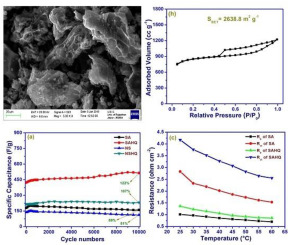当前位置:
X-MOL 学术
›
J. Alloys Compd.
›
论文详情
Our official English website, www.x-mol.net, welcomes your
feedback! (Note: you will need to create a separate account there.)
Enhancement in performance of supercapacitor using eucalyptus leaves derived activated carbon electrode with CH3COONa and HQ electrolytes: A step towards environment benign supercapacitor
Journal of Alloys and Compounds ( IF 5.8 ) Pub Date : 2020-08-01 , DOI: 10.1016/j.jallcom.2020.154956 Dharmendra Jain , Jitendra Kanungo , S.K. Tripathi
Journal of Alloys and Compounds ( IF 5.8 ) Pub Date : 2020-08-01 , DOI: 10.1016/j.jallcom.2020.154956 Dharmendra Jain , Jitendra Kanungo , S.K. Tripathi

|
Abstract The present work specifies capacitive characteristics of supercapacitors built from electrodes derived from biomass (viz., Eucalyptus leaves) and environment-friendly electrolytes. Activated carbon is derived from eucalyptus leaves and used as electrodes. The electrolytes used are environment benign electrolyte sodium acetate (1 M CH3COONa) (free from harmful F- and S- compounds) and CH3COONa added hydroquinone (HQ-redox additive). A chemical activation approach (ZnCl2–KOH) was adopted to synthesize the activated charcoal. Further, it was characterized using BET, XRD, RAMAN, SEM, and FTIR techniques. The specific BET surface area of activated charcoal is found to be 2639 m2 g−1. The performance characteristics of the supercapacitor cells were characterized by cyclic-voltammetry, charge-discharge, and electrochemical impedance spectroscopy techniques. It was observed that the supercapacitor cell utilizing pristine electrolyte CH3COONa shows a specific capacitance of 213 F g−1 and a corresponding energy density of 16.2 WhKg−1 at a specific current of 0.75 A g−1. Interestingly, the values of specific capacitance and energy density increased more than 3-fold to 702 F g−1 and 47.2 WhKg−1 respectively when the electrolyte consisting of redox additives (hydro-quinone) HQ in sodium acetate solution was used. A possible reason for such a behaviour is the Faradic redox reaction between the HQ/Q redox couple. The obtained results were compared for different electrolyte systems 1 M Na2SO4 (with and without HQ) for the same electrode. It was observed that supercapacitor cells fabricated by utilizing CH3COONa based electrolyte system exhibit better capacitive performance. The optimized supercapacitor cells were also tested in a harsh environment by varying the temperature from 25 °C to 60 °C and it shows improvement in capacitive performance with increase in temperature. Cyclic stability of supercapacitor cells was also tested for up to 10,000 cycles and it shows appealing results by offering capacitive retention of more than 122% for the optimized capacitor cell.
中文翻译:

使用桉树叶衍生的活性炭电极与 CH3COONa 和 HQ 电解质增强超级电容器的性能:迈向环境良性超级电容器的一步
摘要 目前的工作详细说明了由源自生物质(即桉树叶)和环境友好型电解质的电极构建的超级电容器的电容特性。活性炭来自桉树叶,用作电极。使用的电解质是环境友好的电解质醋酸钠(1 M CH3COONa)(不含有害的 F- 和 S- 化合物)和 CH3COONa 添加对苯二酚(HQ-氧化还原添加剂)。采用化学活化方法(ZnCl2-KOH)合成活性炭。此外,还使用 BET、XRD、RAMAN、SEM 和 FTIR 技术对其进行了表征。活性炭的比 BET 表面积为 2639 m2 g-1。超级电容器电池的性能特征通过循环伏安法、充放电、和电化学阻抗谱技术。据观察,使用原始电解质 CH3COONa 的超级电容器电池在 0.75 A g-1 的比电流下显示出 213 F g-1 的比电容和 16.2 WhKg-1 的相应能量密度。有趣的是,当使用由乙酸钠溶液中的氧化还原添加剂(氢醌)HQ 组成的电解质时,比电容和能量密度的值分别增加了 3 倍以上,分别达到 702 F g-1 和 47.2 WhKg-1。这种行为的一个可能原因是 HQ/Q 氧化还原对之间的法拉第氧化还原反应。对相同电极的不同电解质系统 1 M Na2SO4(有和没有 HQ)获得的结果进行了比较。据观察,利用 CH3COONa 基电解质体系制造的超级电容器电池表现出更好的电容性能。通过将温度从 25 °C 改变到 60 °C,优化的超级电容器电池还在恶劣的环境中进行了测试,结果显示电容性能随温度升高而提高。超级电容器电池的循环稳定性也经过了长达 10,000 次循环的测试,它通过为优化的电容器电池提供超过 122% 的电容保持率而显示出吸引人的结果。
更新日期:2020-08-01
中文翻译:

使用桉树叶衍生的活性炭电极与 CH3COONa 和 HQ 电解质增强超级电容器的性能:迈向环境良性超级电容器的一步
摘要 目前的工作详细说明了由源自生物质(即桉树叶)和环境友好型电解质的电极构建的超级电容器的电容特性。活性炭来自桉树叶,用作电极。使用的电解质是环境友好的电解质醋酸钠(1 M CH3COONa)(不含有害的 F- 和 S- 化合物)和 CH3COONa 添加对苯二酚(HQ-氧化还原添加剂)。采用化学活化方法(ZnCl2-KOH)合成活性炭。此外,还使用 BET、XRD、RAMAN、SEM 和 FTIR 技术对其进行了表征。活性炭的比 BET 表面积为 2639 m2 g-1。超级电容器电池的性能特征通过循环伏安法、充放电、和电化学阻抗谱技术。据观察,使用原始电解质 CH3COONa 的超级电容器电池在 0.75 A g-1 的比电流下显示出 213 F g-1 的比电容和 16.2 WhKg-1 的相应能量密度。有趣的是,当使用由乙酸钠溶液中的氧化还原添加剂(氢醌)HQ 组成的电解质时,比电容和能量密度的值分别增加了 3 倍以上,分别达到 702 F g-1 和 47.2 WhKg-1。这种行为的一个可能原因是 HQ/Q 氧化还原对之间的法拉第氧化还原反应。对相同电极的不同电解质系统 1 M Na2SO4(有和没有 HQ)获得的结果进行了比较。据观察,利用 CH3COONa 基电解质体系制造的超级电容器电池表现出更好的电容性能。通过将温度从 25 °C 改变到 60 °C,优化的超级电容器电池还在恶劣的环境中进行了测试,结果显示电容性能随温度升高而提高。超级电容器电池的循环稳定性也经过了长达 10,000 次循环的测试,它通过为优化的电容器电池提供超过 122% 的电容保持率而显示出吸引人的结果。











































 京公网安备 11010802027423号
京公网安备 11010802027423号